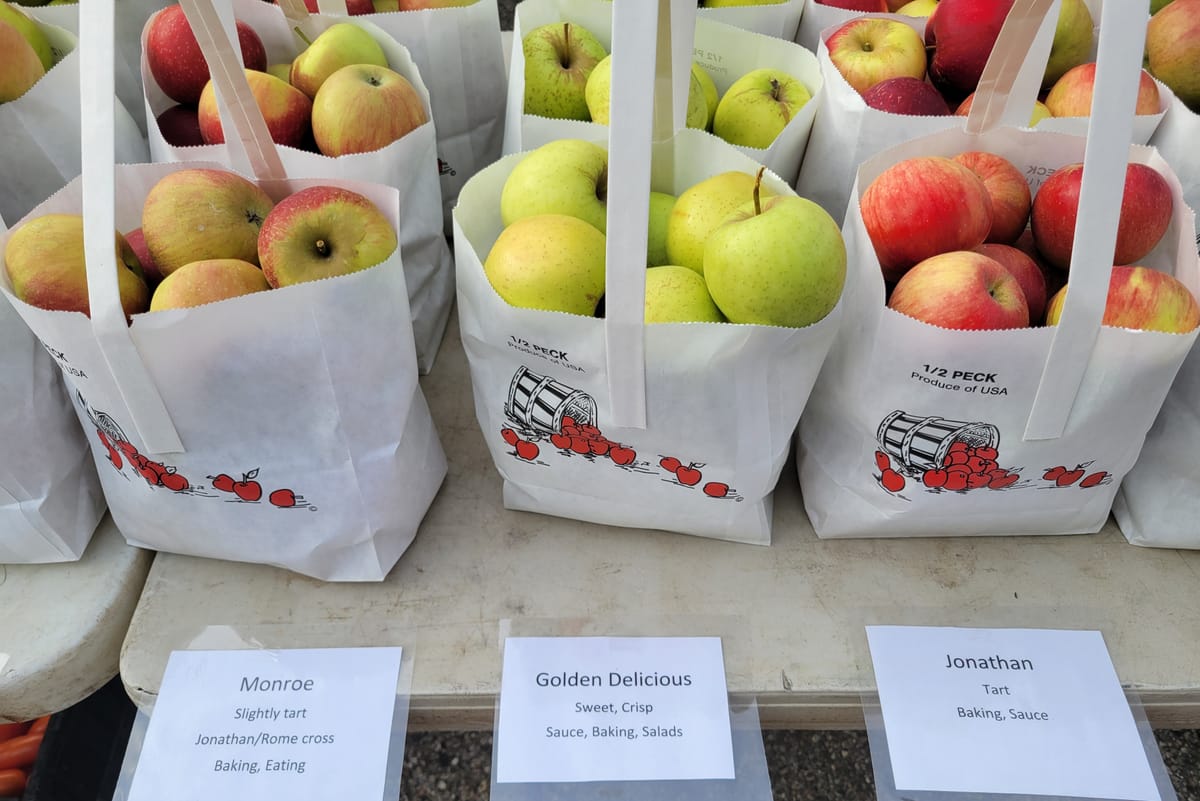On My Plate: Apple Varieties
From Golden Delicious to Monroe apples, fall arrives early this year.

Local apples are being harvested much earlier than usual this year. Scott Downing, our area’s leading apple grower, has completed this year’s harvest. Though he will continue to have plenty of apples at Oxford’s Farmers Market in the weeks ahead, Downing Fruit Farm will not have a pick-your-own option at this year’s annual festival next weekend (more about that in next week’s column).
Getting apples at the Farmers Market is entertaining because of the wide variety available from one week to the next. Apple varieties aren’t all ready for harvesting at the same time, so what’s available in October won’t be the same as in August. Some varieties are well-known, whereas others are unfamiliar. Below are six varieties at last week’s Farmers Market. Note the interconnection among these six.
Golden Delicious, a popular well-known variety, is very sweet, with its distinctive yellow-green skin. Despite its name, Golden Delicious is not related to Red Delicious. The first Golden Delicious tree was discovered in Clay County, West Virginia, in 1912, and it is thought to have grown from a chance seed as a hybrid of Grimes Golden and Golden Reinette. It is now the official state fruit of West Virginia.
Melrose, a relatively crisp and sweet variety, is Scott Downing’s personal favorite. A cross between Jonathan and Stark Delicious, Melrose was developed in 1944 at the Ohio Agricultural Research and Development Center, and it is now Ohio’s official state fruit – take that Golden Delicious and West Virginia.
Jonathan is a medium-sweet apple, named for Jonathan Zander, who is credited with discovering the apple in 1826 on Philip Rick’s Woodstock, New York, farm. Mutsu, developed in Japan in 1949, is a cross between Golden Delicious and a Japanese cultivar named Indo. In the United States, it is also known as Crispin. Jonagold, a relatively crisp and sweet variety, is a cross between Jonathan and Golden Delicious, developed in 1953 at the New York Ag Station. Monroe, a slightly tart variety, is a cross between Jonathan and Rome Beauty, and is named for Monroe County, New York, where it was developed.
A handsome apple tree stands inside the fence surrounding the DeWitt Log Home, Oxford’s oldest structure, dating from 1805, but the apples have been small and hard and not very tasty. Most nineteenth-century apples were used to make cider rather than for direct eating, so presumably these apples are no exception.
A couple of years ago, I showed one of the DeWitt apples to Scott Downing. He held it for a few moments, and thought it might be a Doctor Matthews apple, named for a Tennessee doctor W.F. Matthews. It was an especially popular variety in Indiana in the late nineteenth century, but that was nearly a century after the DeWitt family occupied the home.
I asked local history expert Steve Gordon if the DeWitt Log Home was occupied in the late nineteenth century, the probable age of the apple tree. Steve replied that George and Octavia Cook owned the DeWitt Log Home then, along with several other parcels immediately east of Oxford. Several generations of Cooks were doctors who ran a sanitarium on one of the parcels.
Does that family name sound familiar? In the twentieth century, subsequent generations of the Cook family donated the various parcels to Miami University. One of them – Cook Field – is named for them and is the site of the current controversial university plan to build an arena.
James Rubenstein is president of the Board of Directors for the Oxford Free Press and professor emeritus of geography at Miami University.




